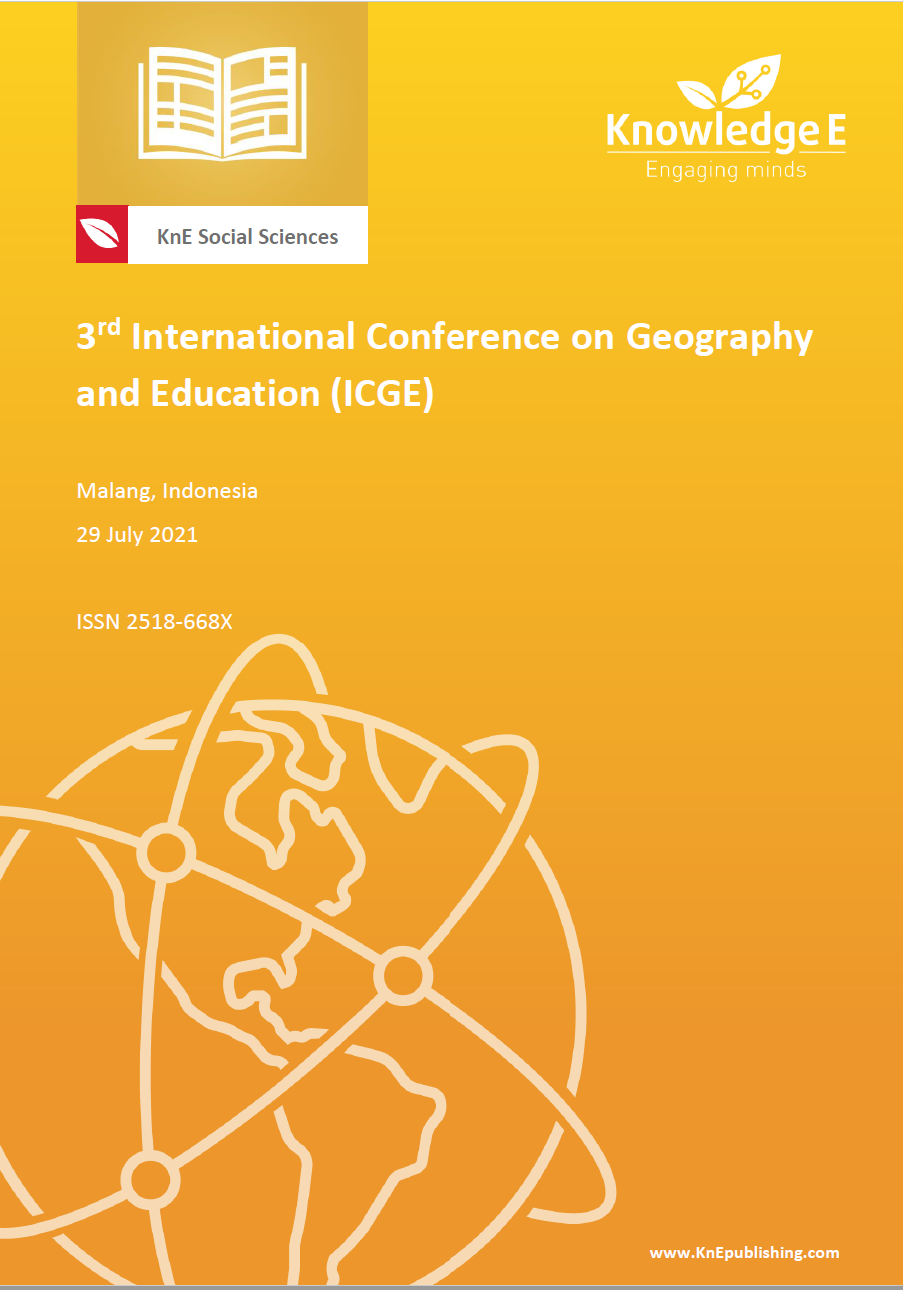Designing Teaching Materials Using ACAR to Inspire Critical and Creative Thinking
DOI:
https://doi.org/10.18502/kss.v7i16.12190Abstract
Teaching materials not only contain text and pictures but have a learning material organization that can build higher-order thinking skills. Teaching materials contain the organizational structure of the sequence of student activities. This research aimed to design ’climatology’ teaching materials that can hone critical and creative thinking skills. Teaching material products were designed to include the preparation of material with a compilation format based on ACAR (activation, confirmation, activities, and resume), which comes from brain-based learning theory. The teaching materials were validated, tested, and implemented in field learning. The results of the evaluation showed that students were able to use the materials to master the concepts used to solve problems. This showed that the ACAR learning model design effectively helped to hone students’ critical and creative thinking skills.
Keywords: ACAR, creative thinking, teaching material
References
Ensar F. How children construct literacy: Piagetian perspective. International Journal of Secondary Education. 2014;2(2):34–39. https://doi.org/10.11648/j.ijsedu.20140202.12.
Devries R. Vygotsky, Piaget, and education: A reciprocal assimilation of theories and educational practices. New Ideas in Psychology. 2000; 18:187–213.
Schunk, D. H. Learning Theories, an Educational Perspective (6th ed.). Boston, MA: Pearson Education Inc;2012.
Reed SK. Cognition theory and applications. 7th ed. Singapore: Cengage Learning Asia Pte Ltd; 2007.
Sousa DA. How the brain learns. 4th ed. Thousand Oaks, California: SAGE; 2011.
Solso RL, Maclin OH, Kimberly MM. Cognitive psychology. 8th ed. Boston, MA: Pearson Education Inc.; 2008.
Jensen E. Brain-based learning. Thousand Oaks, California: SAGE; 2008.
Ansari, U., & Malik, S. K. Image of an effective teacher in 21st century classroom. Journal of Educational and Instructional Studies in the World. 2013;3(4):61–68.
Pacific Policy Research Center. 21st century skills for students and teachers. Research & Evaluation. Honolulu: Kamahameha Schools, Research & Evaluation Division; 2010.
Wentworth H. Education for the 21st century: Here, now and into the future. 21st century fluency series. Porto Alegre: Pontifical Catholic University of Rio Grande do Sul. 2016. Available from: https://ebooks.pucrs.br/edipucrs/relatoriosocial/2016.
Seel NM, Lehmann T, Blumschein P, Podolskiy OA. Instructional design for learning, theoretical foundations. Rotterdam: Sense Publishers; 2017.
Abbie H, Timothy D. The essentials of instructional design. 3rd ed. New York: Routledge; 2016.
Salmiza S. The effectiveness of brain-based teaching approach in dealing with the problems of students’ conceptual understanding and learning motivation towards physics. Asia Pacific Journal of Educators and Education. 2012;26(1):19–29.
Goswami U. Neuroscience and education.Educational Philosophy and Theory.British of Educational Psychology. 2004;74(1)1−10. https://doi.org/10.1080/00131857.2013.866532.
Marina L, Acosta E, Ferri MM. Reading strategies to develop higher thinking skills for reading comprehension. Profile Issues in Teachers’ Professional Development. 2010;12(1):107–123.
Smaldino SE, Lowther DL, Russel JD. Instructional technology & media for learning. 9th ed. Noida: Pearson Prentice Hall; 2008.
Caine RN, Caine G. Understanding a brain-based approach to learning and teaching. Educational Leadership. 1990;48(2):66–70.
Padget S. Creativity and critical thinking for teachers in training. London: Routledge; 2012. https://doi.org/0415692822.
Changwong K. Critical thinking skill development: Analysis of a new learning management model for Thai high schools. Journal of International Studies. 2018;11:37–48. https://doi.org/10.14254/2071-8330.2018/11-2/3.
Gast G. Effective questioning and classroom talk. United Kingdom: NSEAD. 2016. Available from: http://www.nsead.org/downloads/Effective_Questioning&Talk.pdf
Lau JYF. An introduction to critical thinking and creativity, think more, think better. Hoboken, New Jersey: Wiley; 2011.
Liebler N. What is critical thinking? Inquiry: Critical Thinking Across the Disciplines. 1988;1(1):5–5. https://doi.org/10.5840/inquiryctnews19881179
Pucchio, GJ., Mance M., Suttalse, LB., Reali , PD. Creative thinking and creative problem solving in the 21st century. New York: International Center for Studies in Creativity; 2014.
Khuana K, Khuana T, Santiboon T. An instructional design model with the cultivating research-based learning strategies for fostering teacher students’ creative thinking abilities. Academic Journals (Educational Research and Reviews). 2017;12(15):712– 724. https://doi.org/10.5897/ERR2017.3239.
Hong E, Peng Y, O’Neil HF, Wu J. Domain-general and domain-specific creativethinking tests: Effects of gender and item content on test performance. Journal of Creative Behavior. 2013;47(2):89–105. https://doi.org/10.1002/jocb.26.
Baum LM, Newbill PL. Instructional design as critical and creative thinking: A journey through a Jamestown-era Native American village. TechTrends. 2010;54(5):27–37. https://doi.org/10.1007/s11528-010-0434-z.
Drapeau P. Sparking student creativity, practical ways to promote innovative thinking and problem solving. Alexandria, Virginia, USA: Association of Supervision and Curriculum Development.2014.
Glăveanu VP. Distributed creativity thinking outside the box of the creative individual. New York: Springer; 2014. https://doi.org/10.1007/978-3-319-05434-6.
Allen CD. Creative thinking for individuals and teams: An essay on creative thinking for military professionals. Carlisle: United State Army War College; 2012.
Sarukkai S. Science and the ethics of curiosity. Current Science. 2009;97(6):756−767.
Kidd C, Hayden BY. Perspective: The psychology and neuroscience of curiosity. Neuron. 2015;88(3):449–460. https://doi.org/10.1016/j.neuron.2015.09.010.
Litman JA. Psychology of motivation. NewYork: Nova Science Publishers, Inc.; 2007. Curiosity as a feeling of interest and feeling of deprivation: The I/D model of curiosity; p. 149–156.
Duman B. The effect of brain-based instruction to improve on students’ academic achievement in social studies instruction. Paper presented at: 9th International Conference on Engineering Education in San Juan, Puerto Riko 23−28 July; 2006 .
Taniguchi ST. Outdoor education and meaningful learning: Finding the attributes of meaningful learning experiences in an outdoor education program. United State: Brigham Young University; 2004. Available from: https://scholarsarchive.byu.edu/etd/164
Cercone K. Enhancing learning through technology. Chicago: Idea Group Inc; 2006. Brain-based learning; p. 292–322.
The British Neuroscience Association. Neuroscience, the science of the brain: An introduction for young students. Liverpool: British Neuroscience Association; 2003.
Browne MN, Keeley SM. Asking the right questions: A guide to critical thinking. 8th ed. New Jersey: Pearson Education; 2007.
Urban KK. Assessing creativity: The test for creative thinking - Drawing production (TCT-DP). International Education Journal. 2005;6(2):272–280.
Meintjes H, Grosser M. Creative thinking in prospective teachers: The status quo and the impact of contextual factors. South African Journal of Education. 2010;30:361– 386.
Bahr N. Thinking critically about critical thinking in higher education. International Journal for the Scholarship of Teaching and Learning. 2010;4(2):1−17. https://doi.org/10.20429/ijsotl.2010.040209.

